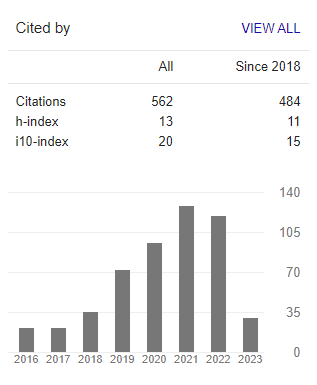Social Escape or Concealment of Sins? The Communication Corruption Analysis of the Secondary Social Media Account Use
Abstract
The overuse of social media has given rise to having secondary accounts on one platform. Various studies have found motives for double accounts, especially on Instagram, such as identity disguise, personal use, creative expression, and privacy. More-login can help manage multiple accounts while maintaining anonymity and security, making it easier for users to explore various aspects of their online presence. Fake Instagram accounts (often called ‘finsta’) are also widespread. Apart from personal motives, there are also ‘professional’. Motives that lead to crime. This article highlights the use of multiple accounts in the context of communication corruption by dissecting aspects of corrupt messages, media misuse, context exploitation, and corrupt behaviour. A case study approach by analysing two participants secondary accounts in depth, accompanied by interviews, digital observations,and document searches, indicates that message corruption occurs in the form of content manipulation, both visual and verbal, concealment of facts, and euphemisms for evil—media corruption by impersonating social media accounts and using media to inflate one’s meaning. Context corruption occurs in inauthentic impression management and misleading public views toward a particular self- picture. Corrupt behaviour is indicated by intentions, motives, and obsession with concealing self-facts and constructing a false social image. The practice of multiple accounts implies that users not only have a ‘other world’ that is free, authentic, and sometimes anti-mainstream but also an image and life imprisoned by the social eye on the other side. So, the second account can be called a social escape room. This research is novel because it first examines the second account phenomenon from the perspective of communication corruption theory with its various consequences.
To cite this article (7th APA style):
Nasution, A. A. & Wijaya, B. S. (2023). Social escape or concealment of sins? The communication corruption: Analysis of the secondary social media account use. Journal Communication Spectrum: Capturing New Perspectives in Communication 13(2), 106-114. http://dx.doi.org/10.36782/jcs.v13i2.2100
Keywords
References
Boyd, D. (2008). It's Complicated: The Social Lives of Networked Teens. Taken Out of Context: American Teen Sociality in Networked Publics. London + New Heaven: Yale University.
De, S. (2021, October 5). What is a finsta? The Instagram trend explained. MakeUseOf. https://www.makeuseof.com/finsta-the-instagram-trend-explained
Fanani, R. Z., Sartika, F., Bioldy, E., Novianda, O., Lasuardy, A., Permatasari, Y. S., & Murtadha, H. A. (2020). How an Automotive Brand Corrupts: Insights from the 2015’s Volkswagen Dieselgate. Jobmark: Journal of Branding and Marketing Communication, 1(2), 152-155. https://doi.org/10.36782/jobmark.v1i2.303
Goffman, E. (1959). The Presentation of Self in Everyday Life. Jakarta: Erlangga.
Harjadi, C. N. (2023, 6 Oktober). Fenomena Second Account di Instagram: Sepenting itukah Identitas Ganda? Good News from Indonesia. https://www.goodnewsfromindonesia.id/2023/10/06/fenomena-second- account-di-instagram
Jung, C. G., as cited in Weaver, T. (2022). Orion Philosophy. Retrieved from https://orionphilosophy.com/
Kriyantono, R. (2010). Teknik Praktis Riset Komunikasi: Disertai Contoh Praktis Riset Media, Public Relations, Advertising, Komunikasi Organisasi, Komunikasi Pemasaran. Jakarta: Kencana.
Marwick, A. (2011). Status Update: Celebrity, Publicity, and Branding in the Social Media Age. Dissertation: New York University.
Merriam, S. (2009). Qualitative research: A guide to design and implementation (Revised and expanded from qualitative research and case study application in education). San Francisco: Jossey-Bass.
Moleong, L. J. 2007. Metodologi Penelitian Kualitatif. Bandung: PT. Remaja Rosdakarya.
Octaviana, M. F., Putri, A. P., Huaida, C. I., Arfani, M. D., Putri, S. N., & Setiawati, M. (2022). HMNS, Paris Fashion Week, and the Corruption of Communication. Jobmark: Journal of Branding and Marketing Communication, 3(1), 95-99. https://doi.org/10.36782/jobmark.v4i1.304
Patton, M. Q. (2015). Qualitative Research & Evaluation Methods: Integrating Theory and Practice. Thousand Oaks: SAGE Publications, Inc.
Prihantoro, E., Damintana, K. P. I., & Ohorella, N. R. (2020). Self-Disclosure dan Keterbukaan Diri dalam Penggunaan Second Account Instagram: Sebuah Analisis Kualitatif Generasi Milenial. Jurnal Ilmu Komunikasi, 18(3), 312- 323.
Priya, A. (2021). Case Study Methodology of Qualitative Research: Key Attributes and Navigating the Conundrums in Its Application. Sociological Bulletin, 70(1), 94-110.
Putri, S. N. (2021). Dark Side of the Moon: The Corruption of Communication in Influencer Marketing. Jobmark: Journal of Branding and Marketing Communication, 3(1), 1-11. https://doi.org/10.36782/jobmark.v3i1.95
Wijaya, B. S., Kusuma, N. W., & Bioldy, E. (2023). The Corruption of Personal Branding Communication in Education and Its Implications for Sustainable Development Goals. Migration Letters, 21(1), 756–764. https://doi.org/10.59670/ml.v21i1.5768
Wijaya, B. S. (2022). On the Corruption of Communication: A Theory of Deception. Studies in Media and Communication, 10(2), 129-144. https://doi.org/10.11114/smc.v10i2.5500
Wijaya, B. S., & Nasution, A. A. (2021). Social media, personal branding, and the hypoesthesia of communication corruption. Cogent Arts & Humanities, 9(1). https://doi.org/10.1080/23311983.2022.2095095.
Wijaya, B. S., Amir, M. T., & Lucyanda, J. (2020). Why Do Educational People Commit Corruption in Communicating Their Personal Brands? In Advances in Social Science, Education and Humanities Research, 532. Proceedings of the International Conference on Educational Sciences and Teacher Profession (ICETeP 2020). http://dx.doi.org/10.2991/assehr.k.210227.014
Wijaya, B. S., Lucyanda, J., & Amir, M. T. (2020). Covid-19 Pandemic, Personal Branding, and the Corruption of Communication. Advances in Social Science, Education and Humanities Research, 596,169-174. Proceedings of the 3rd Jogjakarta Communication Conference (JCC 2021) http://dx.doi.org/10.2991/assehr.k.211121.039
Wijaya, B. S., & Faisal, A. (2016). Political Branding, Public Sphere/Space and the Corruption of Communications. Advance in Social Science, Education and Humanities Research, Volume 84, 280-284. Proceeding International Conference on Ethics in Governance (ICONEG). https://doi.org/10.2991/iconeg-16.2017.63
Wijaya, B. S. (2013). Korupsi Komunikasi dalam Dimensi, Pesan, Media,Konteks, dan Perilaku: Sebuah Proposisi Teoritis Untuk Riset. Journal Communication Spectrum, 3(1), 1-13.
Zhao, S., Grasmuck, S., & Martin, J. (2008). Identity construction on Facebook: Digital empowerment in anchored relationships. Computers in Human Behavior, 24(5), 1816–1836. https://doi.org/10.1016/j.chb.2008.02.012
Refbacks
- There are currently no refbacks.

This work is licensed under a Creative Commons Attribution 3.0 License.
Indexed by:
Archived in:
Listed in:
INTERNATIONAL ASSOCIATION FOR MEDIA AND COMMUNICATION RESEARCH

















